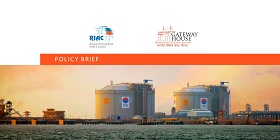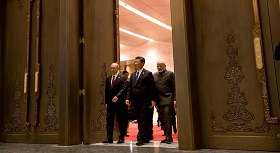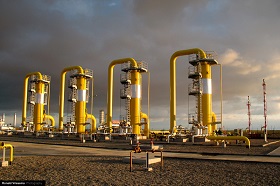Lately, the fight for energy flows in South Asia has intensified to such a degree that it can be compared with the competition in the European market. Just like in Europe, gas contracts in the region reflect the strategic visions of the key geopolitical and regional players with regard to Southeast Asia’s development prospects.
The Persian Gulf countries have historically been the main suppliers of energy resources to South Asia. African, Southeast Asian and Australian suppliers also have a minor presence in the region. Until recently, the regional gas market was considered to be fairly stable and predictable; in some segments, such as LNG supplies to India, the marketplace was effectively monopolized by Qatar.
Qatar does not limit its presence in the region to India. In February 2016, Pakistan contracted the country to supply 3.75 million tonnes of LNG annually for a period of 16 years. But it is time for Qatar to wean from the bumper years of monopoly gas supplies, as the activity of new players could very well bring major changes to the current situation.
The breakthrough in shale mining has opened up new prospects for the United States to export its gas and thus drive competing hydrocarbon providers out of the market. Given the aggressive protectionist policies of the current U.S. administration, it is entirely logical that Washington would want to seize the South Asian market, including by resorting to political pressure. Iran, which possesses massive reserves of natural gas, faces certain difficulties selling it – not just because of the U.S. sanctions, but also due to the lack of sufficient capacities for liquefying gas.
The fight for energy flows in South Asia has intensified to such a degree of late that it can be compared with the competition in the European market. Just like in Europe, gas contracts in the region reflect the strategic visions of the key geopolitical and regional players with regard to Southeast Asia’s development prospects.
The Persian Gulf countries have historically been the main suppliers of energy resources to South Asia. African, Southeast Asian and Australian suppliers also have a minor presence in the region. Until recently, the regional gas market was considered to be fairly stable and predictable; in some segments, such as LNG supplies to India, the marketplace was effectively monopolized by Qatar.
Qatar
Qatar is the unconditional leader in gas supplies to South Asia. In 2004, it concluded an extremely lucrative contract to supply liquefied gas to India until 2029. The true value of this agreement to Qatar became apparent after the sharp drop in global oil prices. India became trapped in its own desire to save money. New Delhi had thought that tying the price of gas to the average oil price in the Japanese market over the preceding five years (which had been growing constantly through the early 2000s) would insure the country against any potential problems. However, the rapid threefold decline in oil prices that followed turned into a nightmare for India, which still had to pay Qatar the maximum agreed sums. In addition to paying more than they had anticipated, the Indian side failed to fulfil its obligations with regard to the agreed volumes of gas purchased. This meant fines, which had amounted to $1.5 billion by early 2016.
India has made serious efforts to revise the agreement with Qatar since Prime Minister Narendra Modi assumed office in 2014. The newly introduced terms involved binding the price of gas to the three-month-average Brent crude price, and also called for restructuring the outstanding debts and fines. In an effort to secure the interest of Qatari suppliers while simultaneously ensuring an uninterrupted gas supply, India proposed that Qatar invest in its processing companies. The idea is for Qatari companies to buy these assets and thus become committed to supplying gas at competitive prices.
Qatar does not limit its presence in the region to India. In February 2016, Pakistan contracted the country to supply 3.75 million tonnes of LNG annually for a period of 16 years, which should cover up to 20 per cent of Pakistan’s energy needs. But it is time for Qatar to wean from the bumper years of monopoly gas supplies, as the activity of new players could very well bring major changes to the current situation.
United States
United States The breakthrough in shale mining has opened up new prospects for the United States to export its gas and thus drive competing hydrocarbon providers out of the market. And this market is worth fighting for. According to Reuters, India was the second-largest importer of liquefied gas in 2017 at 1.7 million tonnes a month on average, leaving Japan a distant third with 1.1 million tonnes. The growth rate of India’s LNG imports is so high that the country might actually come close to the leader China in the near future, especially given that New Delhi briefly exceeded Beijing’s LNG imports in December 2017 (2.4 million tonnes versus 2.3 million tonnes).
India’s state-owned and private companies are actively working to build new LNG terminals and expand existing ones. This effort is expected to increase imports significantly in the next three to five years. The government programme calls for an accelerated transition of the country’s energy sector to clean energy sources, including gas. The number of Indian households using natural gas grew by almost 30 per cent in just two years, from 140 million in 2015 to 181 million in 2017. In 2017, the Indian state-owned company GAIL signed long-term contracts with U.S. LNG suppliers operating terminals in Louisiana and Maryland. The first major deliveries were made later that year. President of the United States Donald Trump noted after his 2017 meeting with Modi that he had aimed at setting a higher price for U.S.-supplied LNG. The actions of U.S. companies can thus be seen as a successful attempt to gain a foothold in a highly promising market with Washington’s political backing.
Given the aggressive protectionist policies of the current U.S. administration, it is entirely logical that Washington would want to seize the South Asian market, including by resorting to political pressure. The visa restrictions and import tariffs imposed by Washington and, most importantly, the requirement that India reduces its trade surplus – all this is aimed, among other things, at gaining advantages in the gas market. In particular, United States Secretary of Energy Rick Perry stated last year that massive U.S. LNG supplies to India would help reduce the mutual trade imbalance.
Tensions in the Middle East, the Saudi-led coalition’s blockade of Qatar, the withdrawal of the United States from the Joint Comprehensive Plan of Action and the threat of new sanctions against Iran all undermine buyers’ confidence in the reliability of Gulf supplies and force them to look elsewhere for their gas. In particular, the United States has demanded that buyers of Iranian hydrocarbons stop purchasing from that country by November 4, 2018.
Iran
Iran, which possesses massive reserves of natural gas, faces certain difficulties selling it – not just because of the U.S. sanctions, but also due to the lack of sufficient capacities for liquefying gas. The Iranian programme to develop its LNG capacities involves massive construction of terminals until 2030, but the protracted sanctions stalled the process considerably. Washington’s recent decision to pull out of the Joint Comprehensive Plan of Action once again returns Iran to a situation of uncertainty, making it hope for India and Pakistan to make a stand. The United States is evidently putting a great deal pressure on these two countries. However, on the one hand, Washington is extremely interested in involving India in an anti-China coalition, so it has to take New Delhi’s position into account and be careful not to go too far. On the other hand, Pakistan, which has long been a loyal ally of the United States, has been drifting towards China over the past decade and may expect Beijing’s support in its stance against Washington.
The problem for Tehran is further aggravated by the fact that Saudi Arabia, a long-term ally of and, more importantly, a generous donor to Pakistan, is putting additional pressure on Islamabad. India, for its part, maintains close relations with Israel, which does not want Iran to succeed. Iran’s desire to secure its gas exports from the influence of the United States and its regional opponents is pushing the country towards rapprochement with Russia. The two countries seemingly doomed to fight in the hydrocarbon market are in fact becoming strategic allies.
Russia
Russia recognizes the vulnerability of relying too heavily on Western gas consumers under the current circumstances, and has thus been taking measures to diversify its supplies. In addition to China, Moscow has turned its attention to other regions, including South Asia, for potential buyers. The terminal in Gujarat, India, took its first batch of liquefied gas from Gazprom on June 4, 2018. Minister of Petroleum and Natural Gas of India Dharmendra Pradhan described the event as the “golden day in India’s energy pursuit,” as Russian supplies, which could turn into a long-term deal, were cheaper than the proposed by Qatari and the United States.
Gazprom’s critics were prompt to point out that the gas being supplied had been purchased on the spot market rather than sourced from the gas giant’s own reserves. Indeed, Gazprom is experiencing certain difficulties in fulfilling the Russia–India contract. Initially, the company relied on gas from the Shtokman field, but the high development costs against the backdrop of the sharp increase in global shale gas production, followed by a drop in oil and gas prices, resulted in the project being frozen. In addition, despite the launch of the Yamal LNG terminal in 2017, Russia is experiencing certain LNG capacity limitations. Nevertheless, Moscow is seeking to gain a foothold in Pakistan, with the countries signing an intergovernmental agreement on LNG supplies in October 2017.
At present, Russia’s Gazprom, Rosneft and NOVATEK are actively working to build LNG terminals in the Baltic, the Arctic and the Far East. In other words, while already supplying spot market gas, Gazprom is in a position to break into the regional market by the time the new Russian LNG terminals have reached their design capacity in the coming years.
A Pipeline Alternative
Given Russia’s geographical remoteness from India, the issue of building pipelines between the two countries has always been seemed a little “out there.” However, projects are in the works that could seriously turn the tables. And Russia’s relations with Iran might play a role here.
The idea to build a gas pipeline across South Asia is nothing new. There is already the off-and-on Peace pipeline from Iran to Pakistan and further to India (known as IP Gas), as well as the TAPI gas pipeline (involving Turkmenistan, Afghanistan, Pakistan and India). It should be noted that Iran and Turkmenistan, the gas producers for both projects, have already conducted the requisite work, and the relevant pipelines have already been laid. The problem is buyers and transit countries stalling the process. In the IP Gas case, the lack of funds and the pressure from the United States and Saudi Arabia has slowed down the pace of construction in Pakistan, while India has withdrawn from the project altogether. TAPI enjoys strong U.S. support, but Afghanistan’s instability, as well as its limited financial resources, remain a deterrent.
The weakest link of the IP Gas and TAPI projects are Pakistan’s guarantees of uninterrupted supplies to India. The political and military standoff between the two countries might undermine the prospects for energy cooperation. In this sense, the idea to lay an offshore pipeline from Iran to India could be a compromise for all the parties involved. The plan to lay the pipeline has been under discussion since the summer of 2017, with Russia and Iran being its most active proponents. In the days leading up to the June summit of the Shanghai Cooperation Organisation in Qingdao, China, the Pakistani press quoted a source in the country’s Ministry of Foreign Affairs as saying that a memorandum of understanding on the construction of an underwater gas pipeline originating in Iran was ready to be signed between Russia, Iran and Pakistan. The project is estimated to cost up to $10 billion, although the final figure will be determined on the basis of calculations provided by Gazprom.
India was also set to take part in the project initially. The three countries would then have had reliable access to competitively priced resources. The parties involved view the underwater pipeline as a separate initiative from the existing overland projects, which should rescue it from the burden of long-standing gas cooperation problems. The pipeline could carry gas from four Iranian fields being developed with Gazprom’s participation, and might also supply Iranian gas from the Persian Gulf in exchange for Russian gas to be sent to northern Iran via the Caspian Sea.
There is the risk that India, ever sceptical of an energy partnership with Pakistan, might eventually abandon the project. Should this happen, China could potentially step in. If Beijing manages to seize the initiative from New Delhi in the Iranian offshore pipeline project, then China and Pakistan will be able to use the China–Pakistan Economic Corridor (CPEC) to supply gas to the former’s western provinces. In fact, RT–Global Resources, a subsidiary of Russia’s Rostec Corporation, is currently laying a gas pipeline with an annual capacity of 12.4 billion cubic metres from a terminal in Karachi to Lahore. Although the actual entry point for the pipeline is Gwadar, it is possible that Karachi will be used to transit gas to China.
India’s possible withdrawal from the project could also have a number of negative consequences for both New Delhi and Moscow. Under the worst-case scenario, India may lose all of its pipeline gas delivery projects, in which Pakistan is the key transit country and China is the primary rival in terms of supplies. India in this case would remain heavily dependent on Qatari LNG. Potential instability in the Persian Gulf, in particular a blockade of Qatar’s or the closure of the Strait of Hormuz, could result in significant risks for Indian buyers. An expansion of the U.S. LNG presence in the region, for its part, may present Washington with instruments for applying pressure (including political pressure) on India, which is critically dependent on energy imports. Finally, Iran’s energy partnership with China could transform into a political partnership, effectively cutting India off from Central Asia and Afghanistan.
There are also a number of potential threats for Russia. The country could see its business opportunities in the Indian market narrowed and might end up with Europe and China as its two key gas consumers. Russian companies would end up being restricted to India’s LNG segment, in which they do not yet feel strong enough. In addition, Moscow’s strategic partnership with New Delhi might weaken. Despite the special relationship between the two countries, the partnership is hampered by relatively underdeveloped economic ties. The pipeline project in question could significantly increase trade between Russia and India, thus boosting cooperation. Additionally, against the backdrop of New Delhi’s opposition to Pakistan’s alliance with China and the potential weakening of ties with Russia, India’s political alignment with the United States will become irreversible.
In this situation, Russian diplomats and energy sector representatives need to exert maximum efforts to bring together the interests of Russia, Iran, Pakistan and India with respect to joint gas projects. The establishment of a partnership in the gas sector, with Russia as the guarantor, would help improve the relationship between these four countries and reduce tensions in the region. Once Pakistan and India become full members of the Shanghai Cooperation Organisation, Moscow will be able to use this format to promote energy projects in South Asia. In addition, Iran’s agreements with Russia and the countries in the region could provide a counterbalance to Washington’s unilateral withdrawal from the nuclear deal, the trade wars, and attempts to create a political and military bloc in South Asia.







